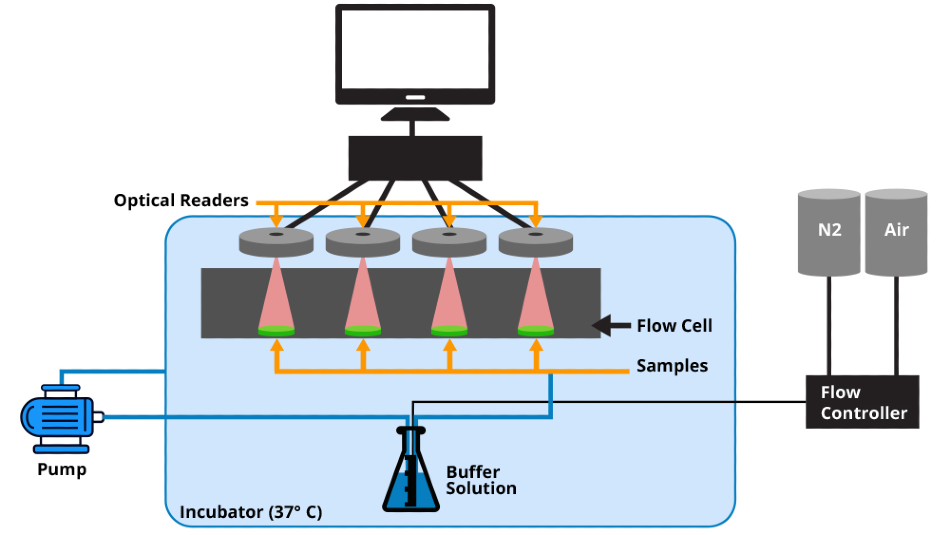May 12 2020
At Texas A&M University, researchers have developed a technology that may be used by people with gout disease to better track their symptoms. The article related to this study was recently published in the February issue of the sensors journal.
 Experimental set-up used in the study to measure urate levels. Image Credit: Dr Mike McShane.
Experimental set-up used in the study to measure urate levels. Image Credit: Dr Mike McShane.
According to the researchers, the new minimally invasive biosensor system might have the potential to enable next-generation point-of-care therapies focused on the personal management of gout, and perhaps other conditions.
Finding more ways to help patients reduce their risks of gout attacks is an important clinical need that hasn’t been looked at in detail. In the future, biosensor technology such as ours can potentially help patients take preemptive steps to reduce the severity of their symptoms and lower their long-term health costs from repeated lab visits.
Dr Mike McShane, Department Head and Professor, Department of Biomedical Engineering, College of Engineering, Texas A&M University
More than 8 million Americans are affected by gout, a painful joint disease. Gout patients have higher urate salt levels in their bloodstream—a condition known as hyperuricemia.
The urate crystals tend to spread out of blood vessels and get deposited in the space between joints. Then, the salt deposits lead to excruciating pain and, in the advanced stages, cause degradation of bones and joints.
Clinical criteria, such as the location of pain, severity of the inflammation, and the frequency of painful incidents, are often used for the diagnosis of gout. However, to achieve a definitive diagnosis, the fluid between the joints is analyzed for the occurrence and amount of urate crystals.
Such laboratory tests can be time-consuming and costly due to factors like labor and equipment charges. Moreover, regular visits for laboratory testing can be hard for elderly patients of gout.
But the levels of urate circulating in the bloodstream can be restricted through medications. Furthermore, avoiding or reducing the intake of foods that are rich in urates, such as seafood and red meat, can also help control blood urate levels.
Maintaining low levels of urate is critical for mitigating gout symptoms. And so, we wanted to create a technology that is reliable and user-friendly so that patients can easily self-monitor their blood urate levels.
Tokunbo Falohun, Study Primary Author and Graduate Student, College of Engineering, Texas A&M University
In the presence of an enzyme called uricase, urate reacts with oxygen to form allantoin. The scientists made use of this understanding to design a system in which urate levels could be supervised indirectly by using benzoporphyrins, an established sensor for oxygen.
Benzoporphyrins are complex molecules with exclusive optical properties that are useful in the development of optical biosensors. Benzoporphyrins get energized upon being hit by light from an LED, and soon lose their excess energy in stages, finally emitting light. However, oxygen atoms can influence the lifetimes or amount of time benzoporphyrins exist in an excited state.
The oxygen atoms can remove some of the extra energy from the benzoporphyrins via collisions. Therefore, if fewer oxygen atoms exist, there are lesser that run into benzoporphyrins, thereby increasing the lives of benzoporphyrins. The reason is that when urate levels are high, the lifetimes of benzoporphyrins must be higher because more oxygen is consumed to produce allantoin.
Using this rationale as the basis, McShane and Falohun developed a technology to quantify the lifetimes of benzoporphyrins. Their technology involved two essential components: a biocompatible hydrogel platform for encapsulating benzoporphyrins and uricase; and an optical device to both generate light and gather light emitted from benzoporphyrins.
The scientists simulated the conditions inside the body by placing the pieces of hydrogels—thin disks with a diameter of a few millimeters—in saline-filled chambers that received a steady flow of oxygen and were constantly maintained at 37 °C.
The researchers then introduced different levels of urate in every chamber. The lifetimes of the benzoporphyrins were evaluated and reported by an external computer linked to the optical system.
When the researchers switched on the LED light, as expected, the urate levels in each chamber instantly influenced the lifetimes of the benzoporphyrins. In other words, if there were more amounts of urate, fewer oxygen atoms were available for collisions, and thus, the lifetimes of the benzoporphyrins increased.
The lifetime values strictly followed the urate levels, but according to McShane and Falohun, more experiments must be carried out to guarantee the long-term stability of the new optical biosensor system to enable the technology to be appropriate for clinical use in future.
But the researchers observed that their biosensor system exhibits the possibility of employing the technology for personal management of gout as the hydrogels are very small to be inserted just beneath the skin, at a site that is close to oxygen-carrying blood vessels.
Moreover, the researchers said that the optical system can be seamlessly connected to any normal computer and that their software has been developed to record urate levels easily. Therefore, gout patients can quantify their urate levels accurately and as frequently as they require.
From a global health perspective, we need to empower people to make informed decisions about their health and well-being. In that regard, our system is a step toward building biomedical technologies for continuous and more frequent monitoring of disease symptoms.
Dr Mike McShane, Department Head and Professor, Department of Biomedical Engineering, College of Engineering, Texas A&M University
This study was financially supported by the National Science Foundation and the Texas A&M University Diversity Fellowship
Journal Reference:
Falohun, T., et al. (2020) An Optical Urate Biosensor Based on Urate Oxidase and Long-Lifetime Metalloporphyrins. Sensors. doi.org/10.3390/s20040959.